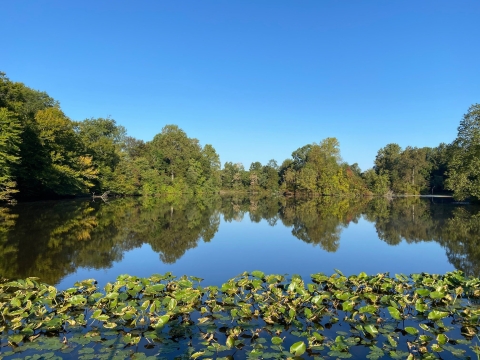About Us
Rappahannock River Valley National Wildlife Refuge was established in 1996 to conserve and protect fish and wildlife resources, including endangered and threatened species and wetlands. Refuge habitats include freshwater tidal marsh, forested swamp, upland deciduous forest, mixed pine forest, and managed grasslands.
The refuge is composed of multiple pieces of land and water spanning Essex, King George, Caroline, Richmond, and Westmoreland counties. Our goal is to protect 20,000 acres of important wildlife habitats along the Rappahannock River and its major tributaries. Our partners and volunteers help us manage the refuge’s lands and waters for wildlife and visitors. As the refuge continues to grow and change over time, so will the opportunities for you to enjoy the refuge!
In 2007, areas of the refuge were designated as an Important Bird Area (IBA). The National Audubon Society designates these areas based on criteria such as population, high concentration in a limited area, or other factors. The IBA designation coincides with areas of high bald eagle concentration.
Our Mission
On the Rappahannock River Valley National Wildlife Refuge, birds will raise their young in native habitats of field, forest, and marsh. They will find rest and nourishment during migration and a haven in winter. We will manage refuge lands and waters with an emphasis on species whose populations have declined, assisting them on the road to recovery.
In partnership with others, we will contribute to the communities where we exist, helping renew the health and vitality of the Rappahannock River and the Chesapeake Bay. We will complement the rich traditions of hunting, fishing, forestry and agriculture on Virginia’s Northern Neck and Middle Peninsula.
The refuge will serve as an outdoor classroom, where students of all ages will study nature’s complexity, contributing to our understanding and appreciation of the natural world and the National Wildlife Refuge System. All those who visit will find enjoyment in the presence of healthy and abundant fish, wildlife, and plants, and will leave with a renewed personal commitment to land conservation and stewardship.
Our History
The refuge is rich with archeological and historic sites detailing the lives of Native Americans, early English colonists, and Revolutionary War soldiers. Today the river continues to sustain many of their direct descendants. Settlement around the Rappahannock River was driven by ecological factors, like rich agricultural soils for growing corn and access to marshes and transportation tributaries.
Indigenous people occupied this land 10,000 years before the arrival of the Europeans. By the 17th century, Rappahannock towns were located along the river from its mouth at the Chesapeake Bay to Port Royal until they were forced to relocate to the Middle Peninsula. The State and Federally recognized Rappahannock Tribe are the descendants of the Indigenous people who met with and engaged Captain John Smith during his 1608 voyage on the Rappahannock River.
The 18th century Bristol Iron Works was located adjacent to the Toby’s Point Unit and the Leedstown Resolves, a protest against the Stamp Act, was signed near the Mothershead Unit in 1766. During the War of 1812, a plantation called Belle Mount, now located at the Cat Point Creek Unit, was burned to the ground during a British raid of Essex and Richmond counties. Before Rappahannock River Valley acquired the Cat Point Creek Unit, it was a popular resort and campground where many locals celebrated important events.
Other Facilities in this Complex
Rappahannock River Valley National Wildlife Refuge is managed as a part of the Eastern Virginia Rivers National Wildlife Refuge Complex, which is comprised of four different refuges. Please click the links below to learn more about these refuges.




